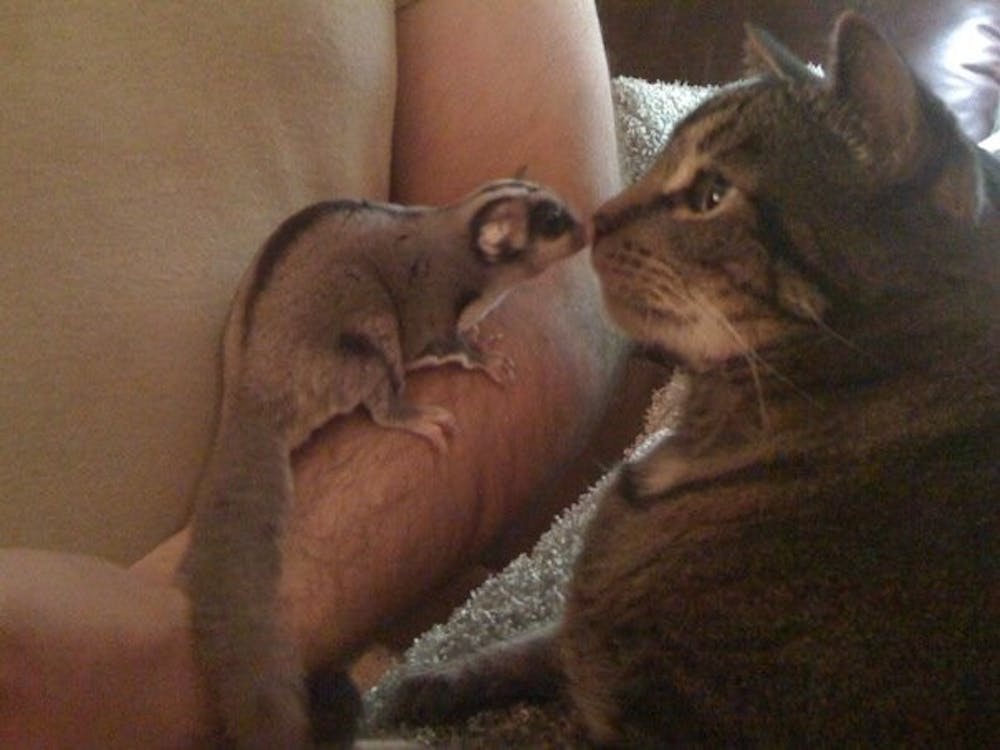Don’t be surprised if you meet Katie Emberton and see a small, furry head with black eyes filled with curiosity peeking out of her pocket. It’s probably just Bruce Wayne — Bruce for short. He’s one of two of this freshman English education major’s sugar gliders.
Sugar gliders are small, squirrel-like creatures with skin flaps between their feet and hands. The marsupials get their name from their ability to spread out their skin flaps and jump fluidly from place to place. They can glide up to 148.5 feet at a time, according to the North American Sugar Glider Association.
Emberton first saw sugar gliders on a trip to the Indiana State Fair about five years ago, when a group had sugar gliders available for the crowds to observe in-between exploring various fried foods and viewing more traditional animals.
“My dad had just moved into an apartment, and he wanted some sort of small animal,” she said. “The apartment wouldn’t allow dogs. My dad’s not exactly a cat person, and he said, ‘Oh, that’d be perfect.’ That’s how we bought the first one.”
This glider became Bruce, named after the superhero vigilante Batman. His tendency to engage in a flight-like means of transportation garnered him the comparison. Emberton described the action as “falling with style.”
Eventually, her family adopted a male and a female sugar glider from an older couple who were no longer able to take care of the animals. The female sugar glider died soon after. Her partner, Taz, would steal her food.
“We tried our hardest to get her to eat,” Emberton said. “We would separate them temporarily for them to eat, but it just wouldn’t work out. She was a little too far gone when we got her.”
Emberton said her sugar gliders enjoy climbing on humans and curling up in tight corners. It might take a while for a sugar glider to warm up to someone, but when they do, they display their affection in different ways than other animals.
“When cats and dogs get used to a person, cats will do the head bumping thing where they bump their head on your knee and dogs will sit on your lap,” she said. “But sugar gliders, when they get used to you, they will jump on you from other people.”
Another sign of fondness reveals itself when a sugar glider attaches itself to the face of the person it prefers.
“It’s kind of frightening, at first, because this thing just jumps onto your face,” she said. “But it’s their way of saying, ‘I trust you and I know you’ll catch me.’”
Emberton’s favorite part of owning sugar gliders comes when someone new notices the large birdcage where Taz and Bruce reside. Reactions range from immediate recognition and interest to fear of the unfamiliar critter.
She had to leave her sugar gliders with her father before leaving for Ball State at the beginning of last semester. Not seeing her sugar gliders and other pets takes a toll on her, but she said she remains confident in her dad’s ability to care for them.
“They’re really great pets for anyone that wants one, and they don’t count as exotic pets so you don’t have to get a license for them,” she said. “But if somebody’s thinking of getting a sugar glider, definitely do your research. There are a lot of places that say certain things about them that really aren’t true.”
OWNING ‘HERPS’
Without pets, Nathan Golub, a senior wildlife biology major, just doesn’t feel complete. So when a strict apartment pet policy coupled with the demanding responsibilities of college, Golub decided to have “herps” as pets.
The term herps encompasses all reptiles and amphibians. Golub owns three types of herps, three dyeing poison dart frogs, a red-eyed tree frog and a false map turtle.
Despite the name, Golub’s dart frogs do not secrete a harmful poison.
“When I tell [visitors] I have dart frogs, they’re like, ‘Oh, how is that legal?’” he said. “It’s actually perfectly legal because they’re not any more dangerous than any other frog.”
Golub said his dart frogs only display lethal characteristic in their natural habitat, where a diet of toxic insects gives them their name.
He purchased the vivid black, yellow and blue frogs at the Indianapolis Reptile Show. Golub also received a fruit fly kit from the vendor who sold him the frogs. This way, Golub can make his frogs’ food source by breeding the fruit flies himself in jars.
Golub said herps, as cold-blooded animals, don’t require as much sustenance as other pets that are endothermic, like dogs. This makes it easier to care for herps on a college budget and schedule.
He describes his herps as hands-off animals.
“[The frogs] get stressed out easily,” Golub said. “They’re not something that you can hold. It’s kind of something that looks pretty, and you just watch it like a fish tank.”
Handling tree frogs and dart frogs with a dry hand can actually burn their skin, Golub said.
As for his false map turtle, he said it either dislikes being held or acts indifferent to the ordeal.
No visitors to Golub’s apartment have ever given a dramatically negative response to his choice of companions.
“Overall, it’s a very positive response,” he said. “People are very excited to see and interested to see these different animals that aren’t really normal pets.”





